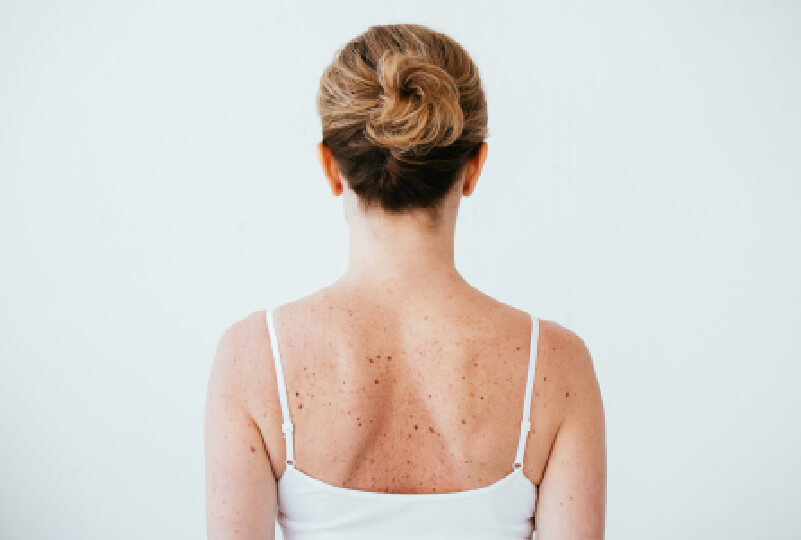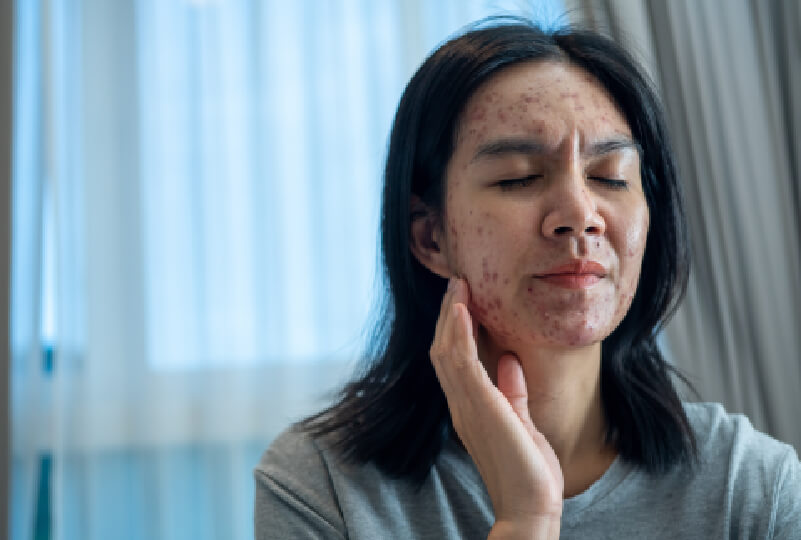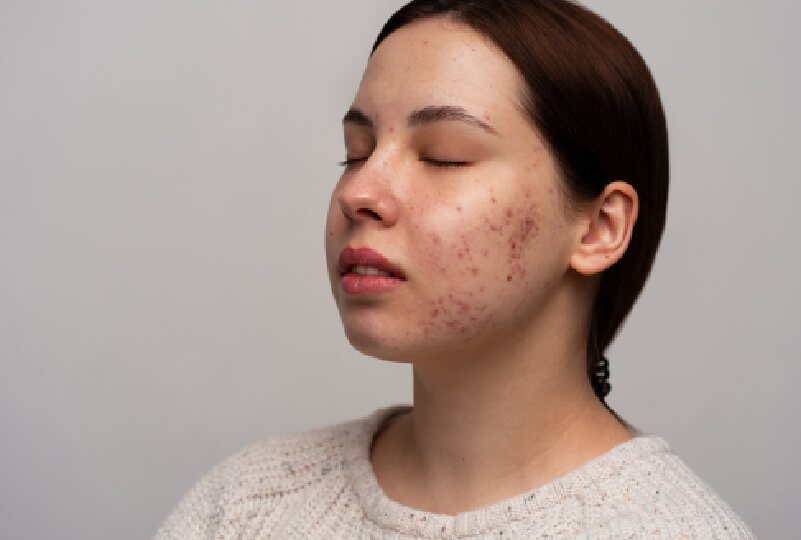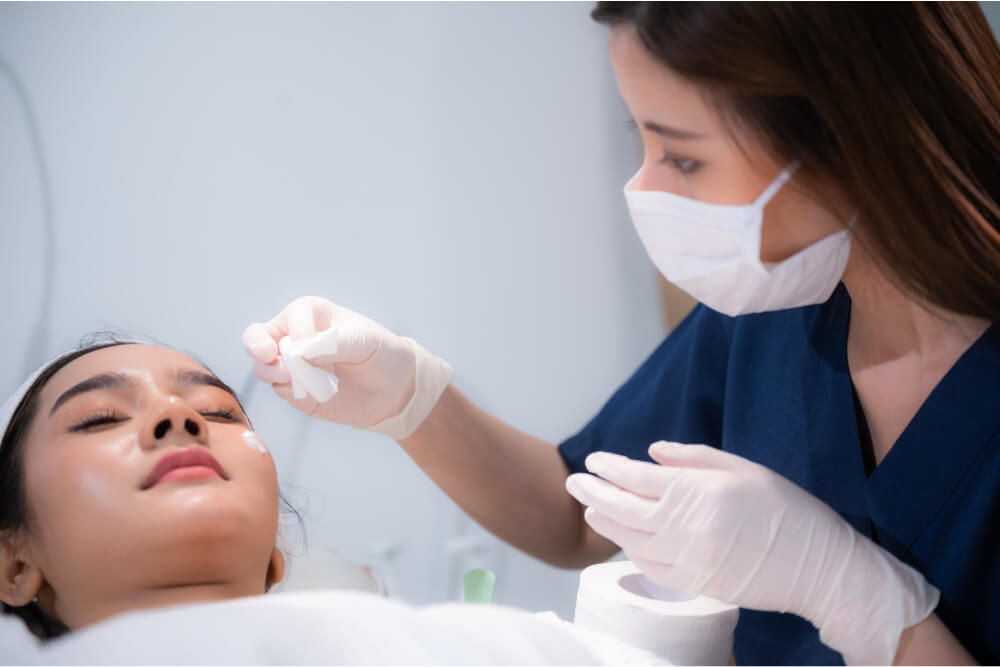Seborrhoea & Seborrheic Dermatitis
What is Seborrhoea?
Seborrhoea is excessive oil production by the sebaceous glands in the skin. This results in excess sebum production leading to a greasy and oily residue on the facial skin that can be unpleasant, inconvenient and a cosmetic nuisance.
Facial skin is often affected by seborrhoea and the excessive oil production results in discomfort, shiny appearance and attracts dirt and causes dirt and particulates to adhere to the skin.
Make up will often be difficult to apply and has a tendency to come off or cake easily. Seborrhoea can also affect the skin of the scalp, underarms, central chest and breast area. Excessive production of sebum in seborrhoea can lead to other skin conditions such as acne and seborrheic dermatitis.
Seborrhoea affects both men and women.
What is Seborrheic Dermatitis?
This is a type of temporary rash that develops in area of excessive oil production such as the scalp, face, central chest, underarms or under breast areas. Seborrheic dermatitis appears as a red, greasy, scaly rash affecting these areas. The skin affected is inflamed and itchy as a consequence.
Seborrheic Dermatitis is a common condition that affects 4% of the UK population. It tends to be more common in men than women.
For sake of precision :
- Seborrhoea = Excess sebum production from oil glands. This results in the affected skin becoming greasy and shiny.
- Seborrheic Dermatitis = An inflammatory reaction of the skin that is triggered in areas of excess oil production that results in formation of a rash that is red, greasy, scaly and itchy.
- The close inter-relation of these two conditions results in the confusing
interchangeability of the names. Although seborrhoea can exist on its own without the rash, seborrheic dermatitis is the formation of the rash that is in part triggered by excessive oil production. Therefore reducing excessive oil production is a key to treating both conditions successfully in the longterm.

Causes of Seborrhoea
In males and females baseline sebum production is generally regulated by underlying genetics. However additional hormonal factors and certain diseases can cause over production of oil.
Oil production is triggered at puberty and hormonal variation around puberty and menopause and various conditions such as polycystic ovarian syndrome (PCOS) or Congenital Adrenal Hyperplasia (CAH) can trigger excessive oil production or seborrhoea.
In many cases adult males and females suffer with seborrhoea naturally with no other underlying trigger other than the fact that there baseline sebaceous activity is naturally high.
Causes of Seborrheic Dermatitis
The cause of seborrheic dermatitis is believed to be a complex interplay the following factors:
Seborrhoea – Excessive production of sebum by the oil secreting (sebaceous)
glands of the skin linked to baseline genetic factors and often exacerbated
hormonal factors.
Increased growth of Malassezia yeast in these excessively oily areas
03
An immune reaction by the body triggered in response to the increased levels of Malassezia yeast and oleic acid ( a byproduct Malassezia yeast growth on the skin). This immune reaction occurs in genetically predisposed individuals but is also triggered by factors such as stress, tiredness, and cold dry weather conditions.
Severity of the problem especially in women can increase due to hormonal fluctuation in conditions such as Polycystic Ovarian Syndrome (PCOS) or even due to peri-menopausal fluctuation of hormones.
Certain medications such as anti-cancer drugs and psychiatric medication such as lithium (used in treatment of bipolar affective disorder) can aggravate seborrheic dermatitis.
Which areas of the body are affected by Seborrheic dermatitis?
Seborrheic Dermatitis causes a red, greasy, scaly and itchy rash that commonly affects areas such as:
Scalp (dandruff)
Face
nose and cheek creases
eyebrows – red flaky rash around the eyebrows
eyelids – the eyelids / lash line (seborrheic blepharitis)
ear – in and around the ear and in the ear canal
Skin folds
Armpits
Groin
Crease below the belly
Crease below the breasts
Central chest area and between breasts
Central back between shoulder blades

Seborrheic Dermatitis in Darker Skin types
It is worth noting that in patients who have darker skin types seborrheic dermatitis can trigger darkening of the rash affected skin. This is known as Post Inflammatory Hyperpigmentation (PIH) of the affected areas. Often in patients with a darker skin type the areas that are routinely affected by the rash appear darker in colour when compared to surrounding areas of skin. These dark patches are of significant cosmetic nuisance and can significantly affect the self-confidence of men and women with darker skin types who suffer with seborrheic dermatitis.
What does Seborrheic Dermatitis Rash look like?
Please take a look at this excellent photo collection of seborrheic dermatitis cases
from the famous Dermnet website. It will show you how typical cases of seborrheic
dermatitis look in different areas of the face, scalp and body.
https://dermnetnz.org/images/seborrhoeic-dermatitis-images
For further information on seborrheic dermatitis please take a look at the British
Association of Dermatology leaflet on Seborrheic Dermatitis by clicking on the link below. A link to the National Eczema Society factsheet on Seborrheic Eczema is also included for further information. These are reliable sources of information for people suffering with seborrheic dermatitis.
https://www.bad.org.uk/pils/seborrhoeic-dermatitis/
https://eczema.org/wp-content/uploads/Seborrhoeic-dermatitis-in-adults-Dec-22-1.pdf
Facial Seborrhoea
Facial Seborrhoea or excessive sebum production on the face predisposes sufferers to conditions such as seborrheic dermatitis. This excessive oil production often affects what is known as the T-Zone of the face.
The facial T-Zone comprises the forehead, nose and chin. Please look at the image below.
The facial T-Zone illustrated above corresponds to the areas of the face that comprise the greatest oil gland density. These areas are therefore the parts of the face that produce the most sebum on the face.
In patients with seborrhoea oil production may be so great that continual mopping, blotting or cleansing of the excess oil may be required. Women with seborrhoea will often have problems with wearing make-up or foundation products due to excessive oil not allowing the make-up to adhere to the skin.

Facial SeThe excessively shiny and oily appearance of seborrhoea sufferers makes for a lack of self-confidence as well as the physical and practical inconvenience causes by excess oil production. These individuals are also more prone to suffer with skin conditions such as seborrheic dermatitis and acne.
Seborrhoea and Seborrheic Dermatitis severity and potential longterm complications
Seborrhoea (oily skin) and seborrheic dermatitis (an inflammatory rash on excessively oily skin areas) is a condition that can vary in severity.
Mild seborrhoea is regarded as a cosmetic nuisance rather than a true condition. Most sufferers both accept that they have an oily or combination skin type that is naturally more greasy in the T-Zone.
Moderate to severe seborrhoea can result in significant pshychosocial impact to the sufferer and therefore warrants more significant treatment
Seborrheic Dermatitis is a chronic issue that triggers a red, greasy and uncomfortable rash to appear. As well as being unpleasant and uncomfortable the rash is highly visible especially when the face is affected. Frequent episodes of seborrheic dermatitis that are left untreated can lead to further skin problems such as:
Infection (Impetiginized Seborrheic Dermatitis)
Skin thickening (Thickening of scale formed by Seborrheic Dermatitis or thickening of the skin itself caused by repeated inflammation or trauma)
Post inflammatory Hyperpigmentation (dark patches forming in affected areas)
Hair loss in individuals affected by Scalp Seborrheic Dermatitis. Hair follicles can be scarred and destroyed by longterm inflammation from chronic seborrheic dermatitis that is left untreated.
Complications of longterm topical steroid use to control recurrent episodes of Seborrheic Dermatitis such as thinning of the skin (atrophic skin changes) and development of visible blood vessels in the skin (telangiectasia).
Longterm facial skin changes and scarring and deformity due to chronic recurrent seborrheic dermatitis and resultant psychosocial impact of these changes.
The supporting medical evidence for low dose Oral Isotretinoin therapy in Seborrhoea and Seborrheic Dermatitis
The fact that oral isotretinoin is effective in the management of seborrhoea and seborrheic dermatitis is well known and understood. The mechanism of action of oral isotretinoin is reduction of sebaceous gland size and function and is therefore naturally going to be an optimal choice in seborrhoea and seborrheic dermatitis. The low doses required are safe and extremely effective in managing the symptoms and
improving the quality of life of male and female patients suffering with moderate to severe seborrhoea and seborrheic dermatitis. The safety and efficacy of low dose oral isotretinoin therapy is confirmed in the numerous studies illustrating its use in seborrhoea and seborrheic dermatitis management. Examples of this are included below.
The articles below show the evidence base for oral isotretinoin in moderate to severe seborrheic dermatitis. The link (found below the summarised conclusion) will take you to a systematic review that was published in the November 2023 edition of the Journal of the American Academy of Dermatology. This study reviewed a total of 7 relevant studies that focussed on treatment of moderate-severe facial and scalp seborrheic dermatitis with oral isotretinoin.
The conclusion of this systematic review study is summarised below:
Conclusion : Isotretinoin treatment resulted in greater improvements in SD symptoms when compared to oral itraconazole, anti-fungal shampoo, or salicylic acid-containing soap. Patients reported less pruritus with isotretinoin (81.9% mean improvement, 95% CI 68.5% to 95.2%) than itraconazole (64.6% mean improvement, 95% CI 53.0% to 76.2%) (P = .003). 2 Of 3 studies totaling 104 patients reporting SD severity on validated scales, 4 patients (4%) reported little-to-no benefit with isotretinoin. The remaining 100 patients (96%) had at least some improvement in SD with isotretinoin, and 47 patients (45%) had complete/excellent clearance. SD
improved with isotretinoin treatment across all studies. Truncal SD had the greatest improvement, followed by the face, then scalp. 3 Relapse rate following isotretinoin cessation was 11.1% at 3 months. 4 Patient-reported QoL postisotretinoin significantly improved (P < .001), 5 independent of isotretinoin dose. On a nominal patient satisfaction scale, 30 patients (63%) reported the greatest improvement with isotretinoin, compared to 2 patients (4%) who reported no improvement. 4 No major adverse events were reported.

https://www.jaad.org/article/S0190-9622(23)01351-8/fulltext
This further study was published in the Journal of the American Academy of Dermatology in May 2025.
The study title is Efficacy, safety, and recurrence in seborrheic dermatitis: A dose-dependent analysis of oral isotretinoin (10 mg vs 20 mg).
The conclusion of the study is summarised as follows:
Conclusion: Both 10 mg and 20 mg isotretinoin effectively reduce disease severity in seborrheic dermatitis, but the 20 mg dose was associated with superior disease control, lower recurrence rates, and higher patient satisfaction.
A link to this study is included below.
https://pubmed.ncbi.nlm.nih.gov/40354944/
This further study below was a retrospective study published in the June 2023 edition of the International Journal of Dermatology. The study concluded that no serious adverse effects were observed when using low dose therapy of 10-20mg daily in patients with moderate to severe seborrheic dermatitis.
Treatments of Seborrhoea and Seborrheic Dermatitis with Oral Isotretinoin
For a Male
Excessive oil production or Seborrhoea is difficult to treat in men. In men the only effective option to reduce excess oil production is oral isotretinoin. It is a highly effective treatment and very safe for adult males. The doses required to reduce oil production significantly are extremely low. Reducing oil production with isotretinoin in males who suffer with moderate to severe seborrheic dermatitis is an excellent treatment when effective longterm control is required. Males suffering with frequent episodes and severe episodes of seborrheic dermatitis can effectively bring the situation under control by microdosing oral isotretinoin.
A dose of typically 10mg – 20mg a day is required to shrink sebaceous glands and bring excessive oil production under control. Oral isotretinoin can be taken long term at this dose safely in men for the treatment of seborrhoea and seborrheic dermatitis.
At small doses (microdosing) isotretinoin regulates and prevents seborrhoea and as a consequence seborrheic dermatitis trigger factors are reduced. Given that most side effects of isotretinoin are dose related they cause little issue to men in the long term. For men there is no issue with isotretinoin causing problems with sperm production. The drug itself is not significantly detectable in sperm. Therefore men who take oral isotretinoin are safe to father children whilst on oral isotretinoin.
If you are an adult male (over 18yrs) commencing oral isotretinoin treatment for seborrheoa or seborrheic dermatitis with Dermacne, treatment is straight forward. Once your initial consultation is complete if oral isotretinoin treatment is a suitable option you can be commenced on your medication as soon as your initial blood test is completed and the results are assessed. You will then need follow up blood tests at 1 month and three monthly intervals after that. If your routine monitoring and blood tests are stable then with low dose isotretinoin (microdosing) courses for seborrheoa 6 monthly blood tests and monitoring may be suitable after the first 12 months of treatment.
The key advantage is that after completing a 1-2 year low dose course of isotretinoin most males can stop the drug and will still have long term significant reduction of symptom severity and episode frequency.
This is because oral isotretinoin causes long term shrinkage of the sebaceous gland leading to long term sebum reduction even when the medication is stopped. This is another reason why oral isotretinoin is an excellent treatment for moderate to severe seborrhoea in males. If preferred small doses of oral isotretinoin can be maintained on a weekly basis indefinitely to keep problems with seborrhoea and seborrheic dermatitis under control.
For a Female
Treatment of excessive oil production or Seborrhoea and Seborrheic Dermatitis has
more treatment options in females versus males.
Androgen receptor blockers are a class of medications that can be used to help
downregulate sebaceous gland function in women. These medications include:
- Spironolactone
- Cyproterone Acetate and Drospirenone (contained within certain oral contraceptives used by dermatologists to control acne and oil production) These drugs are safe when used in women but they cannot be safely used in men. The development of feminising side effects leads to these drugs being contraindicated for use in men.
In females androgen receptor blockers have a multitude of skin health benefits and are effective in treatment of seborrhoea, acne and seborrheic dermatitis. Commencement of these medications will help to reduce oil production but unfortunately unlike oral isotretinoin continual effect necessitates continual use of the drug. If the medication is stopped then the effect is lost. Oil production will increase once more and seborrhoea and seborrheic dermatitis will resume.
Oral isotretinoin causes long term atrophy (shrinkage of the gland) of the sebaceous gland versus androgen receptor blockers which do not change the size but rather block the receptors on the gland that regulate oil secretion. Sebaceous gland atrophy caused by oral isotretinoin has a long term effect in reduction of oil production as it physically reduces sebaceous gland size and activity. This leads to long term remission of symptoms following cessation of a extended low dose course.
The additional benefit of low dose oral isotretinoin in seborrhoea and seborrheic dermatitis management is that it does not interfere with female hormonal balance. Androgen receptor blocker drugs such as spironolactone and cyproterone acetate can result in menstrual irregularity, weight gain, breast pain and tenderness. Hormonal linked side effects such as these do not occur with oral isotretinoin.
The only difference in female oral isotretinoin therapy for seborrheoa and seborrheic dermatitis versus male is that pregnancy prevention whilst on oral isotretinoin therapy is imperative. Dosing regimens of 10-20mg daily are suitable for females as well as males.
As always with Dermacne MHRA guidelines will be followed and appropriate monitoring and pregnancy prevention will be initiated if a course of oral isotretinoin is deemed suitable for management of your seborrhoea or seborrheic dermatitis.